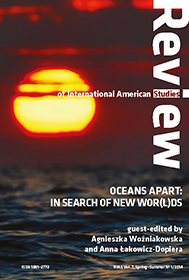Abbate, J. 1999. Inventing the Internet. Cambridge, London: The MIT Press.
Google Scholar
Anderson, B. 2006. [1983] Imagined Communities. Reflections on the Origin and Spread of Nationalism. Rev. Edition. London, New York: Verso.
Google Scholar
Barabási, A.-L. 2002. Linked. The New Science of Networks. Cambridge: Perseus.
Google Scholar
Benesch, K. 2004. ‘The Sea and the American Imagination: An Introduction’, in K. Benesch, J.-K. Adams and K. Schmidt (eds) The Sea and the American Imagination. Tübingen: Stauffenburg, 9-14.
Google Scholar
Bishop, E. 1983. ‘At the Fishhouses’, Complete Poems 1927-1979. London: Chatto Windus.
Google Scholar
Brodersen, A., Scellato, S. and Wattenhofer, M. 2012. ‘Youtube Around the World. Geographic Popularity of Videos’ WWW, Lyon, France.
Google Scholar
Butler P. 2010. ‘Visualizing Friendships’. Facebook. https://www.facebook.com/note.php?note_id=469716398919
Google Scholar
Castells, M. 2010. [1996] The Rise of the Network Society. 2nd ed. vol. 1. Chichester: Wiley-Blackwell.
Google Scholar
Chaon, D. 2009. Await Your Reply. New York: Random House.
Google Scholar
Cheng, X, Dale, C. and Liu, J. 2008. ‘Statistics and Social Network of YouTube Videos’, Simon Fraser University. Tech Report.
Google Scholar
Danoglidis, A. 2013. ‘If the Internet Were an Ocean’. Webmagazin.de. Software & Support Media GmbH. http://webmagazin.de/web/If-the-Internet-were-an-Ocean-Infographic
Google Scholar
Dodge, M. and Kitchin, R. 2001. Mapping Cyberspace. London: Routledge.
Google Scholar
Doreski, C. K. 1993. Elizabeth Bishop: The Restraints of Language. Oxford, New York: Oxford University Press.
Google Scholar
Elsaesser, T. 2009. ‘Tales of Epiphany and Entropy: Around the Worlds in Eighty Clicks’, in P. Snickars and P. Vonderau (eds) The Youtube Reader. Stockholm: National Library of Sweden, 166-186.
Google Scholar
Fishkin, S. F. 2004. ‘Crossroads of Cultures: The Transnational Turn in American Studies—Presidential Address to the American Studies Association’, American Quarterly 57.1 (Nov 12, 2004): 17-57.
Google Scholar
Flint, K. 2009. ‘Transatlantic Currents’, American Literary History 21 (2): 324-334.
Google Scholar
Floridi, L. 2010. Information. A Very Short Introduction. Oxford: Oxford University Press.
Google Scholar
Gehring, E. 2004. Medienmetaphorik. Das Internet im Fokus seiner räumlichen Metaphern. Berlin, Mannheim: Diss.
Google Scholar
Gertler, B. 2011. ‘Self-Knowledge’, The Stanford Encyclopedia of Philosophy. http://plato.stanford.edu/archives/spr2011/entries/self-knowledge/
Google Scholar
Haraway, D. ‘A Cyborg Manifesto. Science, Technology, and Socialist-Feminism in the Late Twentieth Century’, Socialist Review 80: 65-108.
Google Scholar
Hardt, M. and Negri, A. Hayles, K. N. 1999. How We Became Posthuman. Virtual Bodies in Cybernetics, Literature, and Informatics. Chicago, London: The University of Chicago Press.
Google Scholar
Iversen, G. 2009. ‘An Ocean of Sound and Image: Youtube in the Context of Supermodernity’, in P. Snickars and P. Vonderau (eds) The Youtube Reader. Stockholm: National Library of Sweden, 347-357.
Google Scholar
Jenkins, H. 2006. Convergence Culture. Where Old and New Media Collide. New York, London: New York University Press.
Google Scholar
Lankow, J, Ritchie, J. and Crooks, R. 2012. Infographics. The Power of Visual Storytelling. Hoboken: Wiley.
Google Scholar
Lévy, P. 2001. [1997] ‘Collective Intelligence’, excerpt from Collective Intelligence. Repr. in D. Trend (ed.) Reading Digital Culture. Malden, Massachusetts: Blackwell.
Google Scholar
Liebig, M. 1999. Die Infografik. Konstanz: UVK Medien.
Google Scholar
Life in a Day. 2011. Dir. Kevin MacDonald. National Graphic Entertainment, YouTube, Scott Film Prod.
Google Scholar
Manovich, L. 2001. The Language of New Media. Cambridge: MIT Press.
Google Scholar
McClendon, B. 2011. ‘Dive into the Great Barrier Reef with the first underwater panoramas in Google Maps’. Google Official Blog. http://googleblog.blogspot.de/2012/09/dive-into-great-barrier-reef-with-first_25.html
Google Scholar
Melville, H. 1999. [1851] Moby Dick. Norton Critical Edition. H. Parker and H. Hayford (eds). New York: Norton.
Google Scholar
Pease, D. E. 2011. ‘Introduction: Re-mapping the Transnational Turn’, in W. Fluck, D. E. Pease, and J. C. Rowe (eds) Reframing the Transnational Turn in American Studies. Hanover, New Hampshire: Dartmouth College Press, 1-46.
Google Scholar
Reichardt, U. 2010. Globalisierung: Literaturen und Kulturen des Globalen. Berlin: Akademieverlag.
Google Scholar
Rheingold, H. 1993. The Virtual Community: Homesteading on the Electronic Frontier. Reading, Massachusetts: Addison-Wesley Publications.
Google Scholar
Schultz, E. 2001. ‘Ishmael’, in J. B. Gidmark (ed) Encyclopedia of American Literature of the Sea and Great Lakes. Westport, Connecticut: Greenwood Press, 206-207.
Google Scholar
Schwierin, M. 2013. ‘The New Narratives’, in B. Kracke and M. Ries (eds) Expanded Narration. Das neue Erzähle. Bielefeld: Transcript, 22-27.
Google Scholar
Springer, Haskell. America and the Sea. A Literary History. Athens: University of Georgia Press, 1995.
Google Scholar
Thoreau, H. D. 1962. [1854] Walden and Other Writings. New York: Bantam Classics.
Google Scholar
Tokar, A. 2009. Metaphors of the Web 2.0. Frankfurt: Lang.
Google Scholar
Uricchio, W. 2009. ‘The Future of a Medium Once Known as Television’, in P. Snickars and P. Vonderau (eds) The Youtube Reader. Stockholm: National Library of Sweden, 24-39.
Google Scholar
Woiskunski, A. 2005. [2001] ‘Internetmetaphern’, in U. Schmid (ed) Russische Medientheorien, transl. F. Stöcklin, Bern et al.: Haupt.
Google Scholar



 10.31261/RIAS
10.31261/RIAS